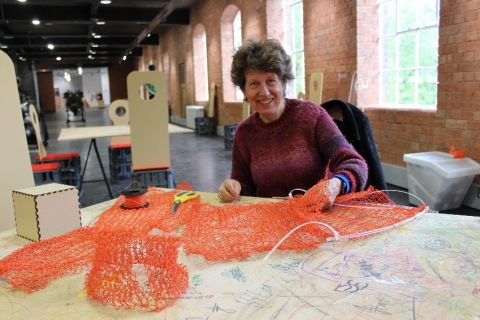Derby Museums publishes report revealing the impressive social impact of the Museum of Making capital project

Museum’s ethos of co-production and collaboration found to have made significant impacts on city and community
Derby Museums today publishes the findings of a Social Return On Investment (SROI) report investigating the social impacts of the Museum of Making as a major capital project.
The Museum of Making at Derby Silk Mill was developed over the last decade to be a place of public pride representing the ‘soul of the city’ with over £18m of grant funding from the National Lottery Heritage Fund, Arts Council England and D2N2 Local Enterprise Partnership alongside support from Derby City Council, Rolls-Royce and a range of charitable trusts and foundations.
The Museum of Making opened its doors to the public in 2021, one of three museums in Derby operated by Derby Museums as an independent charitable trust. Uniquely designed and created by the people of Derby to tell the city’s 300-year history of making and innovation, the Museum of Making attracted over 90,000 visitors in its first year of operation, and over 122,000 last financial year, proving itself to be an attractive and invaluable built heritage asset for Derby that sustains a range of learning and community development programmes.
Tony Butler, Executive Director of Derby Museums, said: “From the outset, Derby Museums was galvanised by the public interest in Derby Silk Mill, perhaps the most recognisable building in the city. This new report shows clear evidence of the significant impacts the Museum of Making project has had on Derby, its communities, visitors, participants, staff, volunteers, makers and artists, as well as Derby Museums itself, and the museum sector more widely.”
Derby Museums used Social Return On Investment (SROI) methodology to measure impacts around the Museum of Making as a major capital project; an outcome-based measurement tool that helps organisations identify, understand and monetise the net economic and social value they create through their activities.
As Tony Butler explained: “Counting numbers tells us nothing about the quality of experience or a project’s impacts on the lives of participants. Qualitatively we know that being active, learning new things, supporting others and working for a common endeavour has positive impacts on health and wellbeing. This sort of activity also builds vital skills and confidence, which can help people be more economically active or contribute more to their communities.”
The Museum of Making is characterised by an ethos of co-production and collaboration and, to date, over 1,500 people have been involved in its development, alongside community and business partners who, together, have gained new skills and contributed more than 40,000 volunteer hours to the project. Participants have been involved in every aspect, from working alongside architects and designers to advising on spatial layouts for galleries, decanting and recanting collections, undertaking historic research, and supporting public events.
A Museum of Making volunteer commented: “There is a commitment to co-production [here] which means volunteers have every opportunity to bring their experience and knowledge to bear on every aspect of the project, and those ideas and suggestions are taken into account and considered seriously. [I can] take my grandchildren [to the Museum of Making] and know that somewhere in this amazing building are the bricks that grandma cleaned.”
The SROI report published by Derby Museums today outlines some significant findings. Derby Silk Mill, a building widely recognised as the site of the world’s first fully mechanised factory, has been saved, protected and enhanced through the Museum of Making project, and the conservation of the Grade I listed 18th Century Robert Bakewell gates has also been ensured.
The project has made 100% of the Museum’s making collections available to the public for the first time, providing activities for nearly 8,000 visitors last year as well as learning sessions for a further 3,500 schoolchildren across the city. The Museum of Making has also been recognised for a number of prestigious awards, which has raised its profile nationally, being nominated as a Finalist for Art Fund Museum of the Year Award 2022 and winning a Family Friendly Award last autumn from Kids in Museums. It was also named East Midlands building of the year at the 2023 Royal Institute of British Architects (RIBA) awards.
According to the report published today, 52 Full-time equivalent (FTE) contracted jobs have been created through the Museum of Making project, as well as a further 153 jobs indirectly. The Annual Economic Impact to Derby is estimated at almost £4 million per year (Derby Museums as a whole is estimated to contribute £7 million) and, according to SROI calculations, the report proposes that for every £1 invested in 2021/2022 museum operations, there’s a social return of £5.86 lasting over the next 5 years. As a result of engaging with the Museum of Making, volunteers reported a notable increase in their confidence and self-esteem, while visitors were found to be more receptive to the city’s wider cultural offer, and local makers were found to benefit from the museum’s peer-to-peer networking opportunities.
The findings of the report illustrate the importance of culture to the social and economic wellbeing of the city; outcomes that will be used to inform future fundraising, partnership work and organisational development at Derby Museums. An Executive Summary can be found on Derby Museums’ website here, together with a downloadable copy of the full report with an outline of the SROI methodology used and a list of key findings.
Image: The Museum of Making at Derby Silk Mill © Art Lewry, Culture Communications Collective/Derby Museums. A volunteer in the development phase of the Museum of Making
